Maharaja
This articleneeds additional citations forverification.(November 2017) |
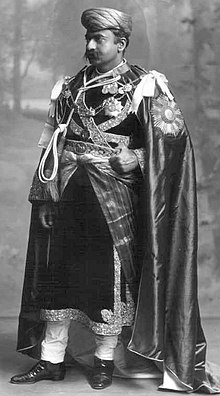

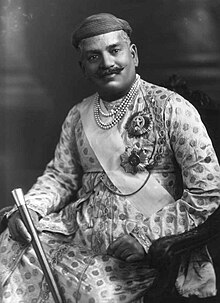
Maharaja[a](also spelledMaharajahorMaharaj) was aprincelyorroyaltitle used by someHindumonarchssince theancienttimes. Maharaja is a compound word ofMaha(great) andRaja(king).[2]In classical and medievalNorth India,it was used generally byvassalmonarchs, though it was used by independent monarchs as well, especially in the early modern era. It ranks higher thanRajawhich denoted a high-ranking noble or minor prince who ruled a small estate. Monarchs who became independent usually change their title toMaharajadhirajawhich denotes asovereignand independent status.[3]
The form "Maharaj" (without "-a" ) indicates a separation of noble and religious offices, although since inHindithe suffix-ais silent, the two titles are near homophones. Historically the title Maharajas were first used by rulers ofMahajanapadas.Most high-ranking Hindu princely monarchs of theIndian Empireduring the British era were styled Maharajas such as the Maharaja of Kashmir and Jammu, Maharaja of Mysore and Maharaja of Gwalior.
It's variants include Maharana and Maharao.
Etymology[edit]

The wordMaharajaoriginates inSanskritand is a compoundkarmadhārayaterm frommahānt-"great" andrājan"ruler, king" ). It has the Latincognatesmagnum"great" andrex"king".[4][5]Due to Sanskrit's major influence on the vocabulary of most languages inGreater IndiaandSoutheast Asia,the term Maharaja is common to many modernIndo-AryanandDravidian languages.The Sanskrit title Maharaja was originally used only for rulers who ruled a considerably large region with minor tributary rulers under them. Since medieval times, the title was used by (Hindu) monarchs of lesser states claiming descent fromancientmaharajas.
Indian subcontinent[edit]
Rajaas a ruler's title[edit]
On the eve ofindependencein 1947, theIndian Empirecontained more than 600princely states,each with its own native ruler, often styledRajaorRanaorThakur(if the ruler wereHindu) orNawab(if he wereMuslim), with a host of less current titles as well.
TheBritishdirectly ruled two-thirds of theIndian subcontinent;the rest was underindirect ruleby the above-mentioned princes under the considerable influence of British representatives, such asResidents,at their courts.
The word Maharaja may be understood simply to mean "ruler" or "king", in spite of its literal translation as "great king". This was because only a handful of the states were truly powerful and wealthy enough for their rulers to be considered 'great' monarchs; the remaining were minorprincely states,sometimes little more than towns or groups of villages. The word, however, can also mean emperor in contemporary Indian usage.
The title of Maharaja was not as common before the gradual British colonisation of India, upon and after which manyrajasand otherwise styled Hindu rulers were elevated to Maharajas, regardless of the fact that scores of these new Maharajas ruled small states, sometimes for some reason unrelated to the eminence of the state, for example, support to the British in Afghanistan,World War IorWorld War II.The Maharaja of Punjab in the 19th century was Maharaja Ranjit Singh. He earned this title by keeping the Britishers beyond the Sutlej and even crushed the Afghan Empire. Maharajas in the twentieth century were the Maharaja ofCochinandMaharaja Jagatjit SinghofKapurthala.Apart from princely states, rulers of some large and extended zamindaris were also awarded the title of Maharaja. The rulers ofJeypore,Darbhanga,Vizianagaram,ParlakhemundiGidhaurwere a few zamindars who were titled Maharaja for their cordiality and contribution to the British Raj.
- Variations of this title include the following, each combiningMaha-"great" with an alternative form ofRaja'king', so all meaning 'Great King':Maharana(as inUdaipur),Maharawal(as inDungarpur/Jaisalmer),Maharawat(Pratapgarh),Maharao(as inKotah,Bundi) andMaharaol(as inBaria).
- Maharajahhas taken on new spellings due to the time change and migration. It has even been shortened toMahrajandMarajbut the most common isMaharajahandMaharaj.
- Despite its literal meaning, unlike many other titles meaningGreat King,neither Maharaja norRajadhiraja('King of Kings'), nor even its equivalent amongst. Maharaja, 'Maharajadhiraja', never reached the standing required for imperial rank, as each was soon the object of title inflation.[citation needed]Instead, the Indian title which is commonly rendered as Emperor isSamrator Samraj(a), a personal distinction achieved only by theMauryansand theVakatakarulerPravarasena I.[6]Muslim equivalent of emperor would bePadshah(of Persian origin), notably applied to theMughal dynasty,the paramount power until the British established their raj.
|
|
|
|
Compound and dynastic ruler titles[edit]
- Dharma-maharajawas the devout title (compare Rajadharma) of the rulers of theGanga dynasty.
In theMughal Empireit was quite common to award to various princes (hereditary or not) a series of lofty titles as a matter of protocolary rank. The British would, as paramount power do the same. Many of these (see also above) elaborate explicitly on the title Maharaja, in the following descending order:
- Maharajadhiraja Bahadur(orMaharajadhiraj Bahadur): Great King over Kings, a title of honour, one degree higher than Maharajadhiraja.
- Maharajadhiraja(orMaharajadhiraj): Great King over Kings, a title of honour, one degree higher than Sawai Maharaja Bahadur.
- Sawai Maharaja Bahadur:a title of honour, one degree higher than Sawai Maharaja. (the termbahadur,originally 'brave' in Persian, was often used for 'one-degree' higher', and 'sawai' is 'one and a quarter higher', i.e. just a step above bahadur)
- Sawai Maharaja:a title of honour one degree higher than Maharaja Bahadur; as granted (directly) to the Rajas of Ajaygarh.
- Maharaja Bahadur:a title of honour, one degree higher than Maharaja.
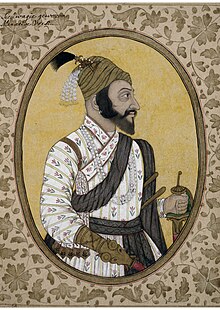
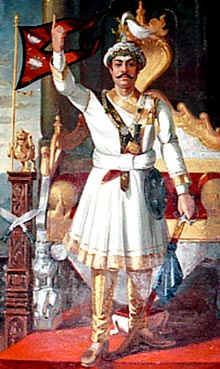

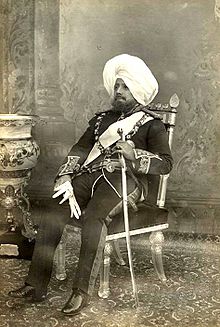
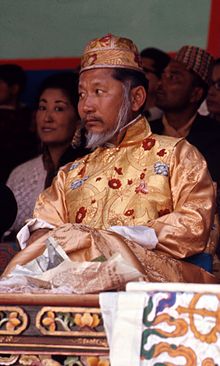
Furthermore, there were various compound titles simply including other princely styles, such as:
- MaharajaChatrapatiinSatara,the paramount state of theMaratha Confederacy
- H.H. theMaharaj RanaofJhalawar
- Maharaja-i-Rajgan:great prince amongst princes
- MaharajaSenaSahib SubahofNagpur,anotherMarathastate
- MaharajBabu:ARajputtitle similar to Maharaja. Used by the ruling Chiefs of Hazari Estate, Dohazari of SouthChittagong.
- For details concerning various titles containingsahib,see there
Certain Hindu dynasties even came to use a unique style, including a term which as such is not of princely rank, e.g.Maharaja GaikwarofBaroda,Maharaja ScindiaofGwalior,Maharaja Holkarof Indore, three of the very highest ranking rulingMarathahouses.
Chakravarti[edit]
Chakravartiis aSanskritterm for "emperor". The meaning of chakravarti is "he, whose wheels (ofchariot) are moving "which symbolises that the leader who is a war hero, who commands over vast land and sea, the one who rules the people with dedication. In the Mahabharata, theChakravarti Bharatis known to have ruled the entire sub-continent of India brought golden age to his empire. He is called as chakravarti. The wife of a Chakravartin or it's female Chakravartin is called a Chakaravartini.
Yuvaraja[edit]
Yuvarajameans thecrown princeof the kingdom or empire. He is granted with certain powers and responsibilities so that he can be prepared to take over as the Maharaja. His wife is called Yuvarani.
Rajakumara[edit]
Rajakumara is the son of a king who is not the heir apparent. He is conferred with certain duties or powers per the king's wishes. The daughter of a king who is not the heir apparent is called Rajakumari.
Maharani[edit]
Maharani usually denotes the wife of a Maharaja (orMaharana,Maharao,Maharawal) or in rare cases, in some states where it was customary, awoman ruling without a husband.[7]
Rajamata[edit]
In case a child king is crowned, the mother of the king takes charge of the kingdom and acts as a regent. Until the young king is of the age, theRajmata(Queen mother) administers the kingdom. Famous examples include Rajamata Shetu Lakshmi Bai of Travancore dynasty, Gowri Lakshmi Bai, Maharaji (later Rajamata) Rudrama Devi of Kakatiya dynasty.[8][9]When the king is present, the Rajamata being the mother of the king, might given ceremonial roles. A famous Rajamata who functioned with the king is RajamataJijabaiof theMaratha Kingdom,accompanying theChhatrapati(king).[10]
Noble and honourary use[edit]
LikeRajaand various other titles,Maharajawas repeatedly awarded to notables without a princely state, such aszamindars.
- One Raja ofLambagraon,aJagir(inHimachal Pradesh) who served in the colonial army was granted personally the non-hereditary title of Maharaja of Kangra-Lambagraon and a personal 11-guns salute, so neither honour passed on to his son and heir.
- In the major, Muslim realm ofHyderabad and Berar,there was a system of ennobling titles for the Nizam's courtiers, conferring a specific rank without any (e)state of their own, not unlike peerage titles without an actual fief in the UK, the highest titles for Hindu nobles beingMaharaja BahadurandMaharaja,aboveVant, Raja Rai-i-Rayan Bahadur, Raja Rai Bahadur, Raja Bahadur, RajaandRai;for their Muslim counterparts there were alternative titles, the highest beingJahandUmara;e.g. theDiwan(Prime Minister)Maharaja Sir Kishen Pershad,held such a Maharaja-title.
Derived style for princes of the blood[edit]
Maharaj Kumar(orMaharajkumar) means son of a Maharaja or Heir-Apparent; the female equivalent isMaharaj Kumari (Maharajkumari): daughter of a Maharaja.
Nepal[edit]

The GorkhaKings of Nepal(now a republic) used the title ofMahārājādhirājawhich was "King of Great Kings", a title of honour, a degree higher than Mahārājā. Rana Prime ministers of Nepalused the title ofShree TeenMaharaja while the Gorkha Kings used Shree Panch Maharajadhiraja.
Southeast Asia[edit]
Dali[edit]
Duan Xingzhi, the last monarch of theKingdom of Dali,submitted to theMongol Empire,and in return was enfeoffed asMaharaja( ma kha la tha ) of Dali, continuing to rule the area (but subordinated toYuanprinces and Muslim governors of Yunnan), until theMing conquest of Yunnan.[11]
Indonesia[edit]
When theIndonesian Archipelagowas still predominantly Hindu-Buddhist (circa 3rd century CE until the 15th century CE), all of theIndianised kingdomswhich ruled different areas of thearchipelagowas ruled by a "Maharaja" or simply referred by the locals as "Raja", such as the first and oldest Hindu kingdom of Indonesia theKutai Martadipurain easternBorneo,theTarumanegara,theSrivijaya,theMajapahitand numerous other kingdoms. Traditional titles remain in use for other members of royalty, such asPangeran Ratufor the heir and other local-Malay titles such as "Paduka Sri". The title "Maharaja" has been used to refer to kings of ancient Indianised kingdoms, such as MaharajaMulavarmanking ofKutai Martadipuraand MaharajaPurnawarmanking ofTarumanegara.
Maharaja was also part of the titles of the nobility in the Sumatran sultanate ofAceh.In the past, the title of Maharaja is given to a leader of the unreigning noble family and the Prime Minister Maharaja Mangkubumi. The last Prime Minister of Aceh who was installed to be the Maharaja Mangkubumi, Habib Abdurrahman el Zahir, who also acted as the foreign affairs minister of Aceh but was deposed and exiled toJeddahby the colonialDutch East Indiesauthorities in October 1878.
Malaysia[edit]
In peninsularMalaysia:
- Maharaja was the title of the monarch of the peninsular Malay state ofJohor(e) from 1873 to 1885. The Arabic, Muslim titleSultan,often considered of higher rank, was re-adopted later and remains in current usage.
- The title Bendahara Seri Maharaja was used by the ruler ofPahang(1623–1853 in personal union with Johor, eventually becoming a fief of theBendaharafamily), till on 6 August 1882 Tuanku Ahmad al-Muadzam Shah ibni al-Marhum Tun Ali adopted the title, Sultan.
In northernBorneo,the title Maharajah of Sabah and Rajah ofGayaandSandakanwas used from 29 December 1877 to 26 August 1881 byBaron von Overbeck(compareWhite Rajah).[12]
The Englishman Capt.James Brookewas declared as Rajah Brooke by theSultan of Bruneifor his role in pacifying the Sarawak revolt against the Sultan during the Raffles' stint. The wordRajahderived from the word Maharaja. In 1842, the Sultan of Brunei ceded Sarawak to Rajah Brooke who founded theKingdom of Sarawakand a line of dynastic monarchs known as theWhite Rajahs.
In contemporary Malay usage, the titleMaharajarefers to anemperor,e.g. "Maharaja Jepun"("Emperor of Japan").
Brunei[edit]
In Seri Malayas of theSrivijaya,under the Srivijaya satellite empire of theMajapahitEmpire dominated over the whole Malayas far-reaching the presentPhilippine Archipelago,Malaysia, Brunei, Indonesia under the Srivijaya Empire of the Majapahit King Maharaja Pamariwasa. The latter's daughter Es-kander was married to an Arab (Zein Ul-Abidin), the third Makdum who promulgated Koranic studies (Madrassahs) and was a Srivijaya ruler in Seri who were a Srivijaya Monarchy. In the 12th century with the fall of the empire, the Seri King being a Muslim established theSultanate of Bruneiin 1363 with the throne name Sultan Mohamad Shah. In 1426, he established the sultanate of sulu as his death was recorded in 1431 Mt. Makatangis Sulu grave and 1432 Brunei grave. Both Sulu and Brunei claim the honor of his grave, while his brother, a Johore (Singapore) Prince Makdum Karim (Sharif Kabungsuwan of Malabang Lanao) the second Makdum after the first one Makdum Tuan Masha'ik. Karim ul-makdum re=enforced Islam, a Srivijaya Johore ruler, later established the Sultanate of Maguindanao-Ranao (Mindanao) after taking the political authority of his father-in-law Tomaoi Aliwya of the Maguiindanao family dynasty. He adapted the title as sultan Aliwya (Sharif Kabungsuwan), the first Maguindanao Sultan. The second and third Makdum's father was Sultan Betatar of Taif Arabia who was the 9th progeny of Hasan, the grandson of prophet Sayyidina Muhammad.
Compound Malay titles[edit]
The word can also be part of titles used byMalaynobility:
- Maharaja Lelawas the title of the ruler of the State ofNaning(founded 1641), until it was annexed by the United Kingdom toMalaccain 1832.
Most famous wasBendaharaSeri MaharajaTun Mutahir of Malacca(executed 1509) and DatukMaharaja LelaPandak Lam ofPerak(executed 1876).
Thepalacemarshalof theYang di-Pertuan Agong(head of state) of modernMalaysiais calledDatuk Maharaja Lela Penghulu Istana Negara.
Eventually, Maharajah Adinda was also used to refer to a particular lineage within the royal families.
Thailand[edit]

TheKing of Thailandhas been called a "Maharaj" (Thai:มหาราชา).
See also[edit]
Notes[edit]
References[edit]
- ^"Maharaja".Oxford English Dictionary(Online ed.).Oxford University Press.(Subscription orparticipating institution membershiprequired.)
- ^Tej Ram Sharma (1989).A.Concept Publishing Company.ISBN81-7022-251-6.
... Literally Maharaja means 'a great king'...
- ^"Maharaja | Hindu title".Encyclopædia Britannica.Retrieved17 April2021.
- ^Thomas J. Samuelian (2000),Armenian origins: an overview of ancient and modern sources and theories,Iravunq Publishing House,
... Cognate Chart Sanskrit: Maha Greek: Mega English: Much...
- ^Horace G. Danner, Roger Noël,An introduction to an academic vocabulary: word clusters from Latin, Greek and German,
... Mag-, great; maj-, greater; max-, greatest; IE base: meg-, yields Sanskrit maha; English much; Greek mega...
- ^https://books.google.co.in/books?id=GW5Gx0HSXKUC&pg=PA482&redir_esc=y#v=onepage&q&f=false
- ^Hansdev Patel (1998).Royal Families and Palaces of Gujarat.Scorpion Cavendish.ISBN1-900269-20-1.
- ^"Sethu Lakshmi Bayi, The Feminist Queen of the House of Travancore".Thebetterindia.27 October 2016.Retrieved17 April2021.
- ^Srinivas, Pendem (14 March 2016)."Rudramadevi History, Achievements and Administration".Indiathedestiny.Retrieved17 April2021.
- ^"Rajmata Jijau Birthplace, Sindkhed Raja | District Buldhana, Government of Maharashtra | India".Buldhana.nic.in.Retrieved17 April2021.
- ^Yang, Bin (2008a),"Chapter 3: Military Campaigns against Yunnan: A Cross-Regional Analysis",Between Winds and Clouds: The Making of Yunnan (Second Century BCE to Twentieth Century CE),Columbia University Press
- ^P. J. Rivers, "The Origin of 'Sabah' and a Reappraisal of Overbeck as Maharajah",Journal of the Malaysian Branch of the Royal Asiatic Society77(1), 2004; pp. 79–80








